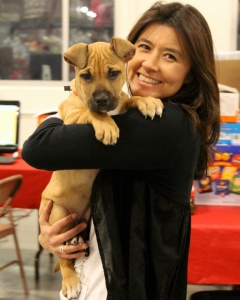 So you’ve adopted your new family member and are ready to head home. What now? Here are some important things to keep in mind:
So you’ve adopted your new family member and are ready to head home. What now? Here are some important things to keep in mind:
- If you’re bringing home a new dog, introduce him to your existing pack on neutral territory. Walk the dogs side by side a safe distance apart, letting them have the occasional sniff. Watch for signs of stress: stiff bodies, raised hair, intense staring, and bared teeth can all signal an impending tussle. Try to stay as relaxed as possible and speak in soothing tones to diffuse any tension. If the walk goes well, allow the dogs to meet and explore in an enclosed area, like a neutral yard. Once at home, beware of possible triggers: food, toys, and even people can be considered high-value treats, so consider feeding separately and limiting toys until you know better how your dogs will react. For more information on improving first meetings, click here.
- Remember that this is a brand new place for your dog, and he may not yet know that you are his family. Rescued dogs are more prone to bolt, so consider double-leashing your dog initially when on walks (leashes on two different collars or one on a harness and one on a collar, in case he pulls out of a collar). Likewise, even in a fenced-in yard, it doesn’t hurt to keep your dog leashed and graduate to having him drag a long leash until you know him better. Never leave your dog alone in the yard, as he may be able to climb or jump a fence. If your dog is not already microchipped, consider having this done at a shelter or vet’s office. If your dog does happen to get loose, he can be scanned for a microchip when found and the microchip company will have your contact information. A microchip is not a GPS, so you’ll want to be sure your contact information is always up to date!
- Plan to take your new adoptee to your vet within a few days of bringing him home. A thorough evaluation lets your vet get to know your new pet and vaccinate him as needed (particularly puppies and kittens, who will likely require at least one more round of shots), and you’ll get a thorough health evaluation. Let your vet know that you just rescued your new friend; some vets give an initial discount for an adopted animal! Don’t forget to pick up flea medicine and heartworm preventative.
- If you are switching your new pet’s food, plan to do it slowly over several days. Because abrupt changes to your dog or cat’s diet can cause stomach issues, slowly mix the new food with the food the rescue or shelter has been feeding. Need more information about what food to feed your new family member? Check out Dog Food Advisor.
- Consider crate-training your new dog. If done properly, crate-training creates a safe, secure place for your dog to decompress. It gives him a place to relax if he is tired or overwhelmed, and it keeps him safe from potentially eating things he shouldn’t when you’re not home. For effective crate-training, never use your dog’s crate as punishment. Find more information on crate-training, click here.
- Most importantly, give your new friend time to settle in! Think of your new pet as a foreign exchange student: he is in a new place with a
 language and culture that he’s never known. It will take some time for him to learn the house rules and understand his new routine. Even housetrained dogs may have a few accidents. Give him time to decompress, use lots of positive reinforcement, and let him know that you love him unconditionally. It can take a few weeks for your dog to feel at home, and then you will keep seeing changes over time. In the long run, these first few weeks will be absolutely worth it. This is your new best friend, after all!
language and culture that he’s never known. It will take some time for him to learn the house rules and understand his new routine. Even housetrained dogs may have a few accidents. Give him time to decompress, use lots of positive reinforcement, and let him know that you love him unconditionally. It can take a few weeks for your dog to feel at home, and then you will keep seeing changes over time. In the long run, these first few weeks will be absolutely worth it. This is your new best friend, after all!







